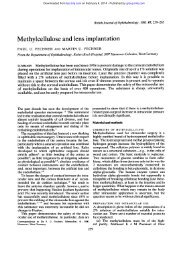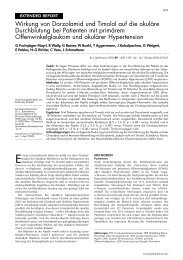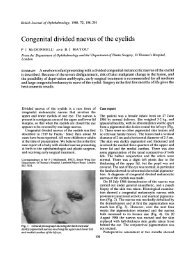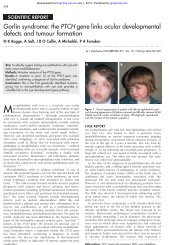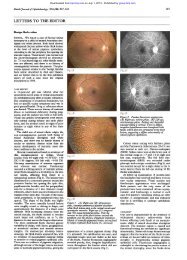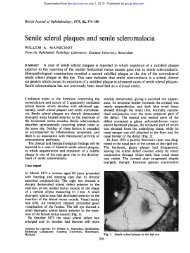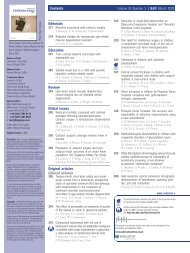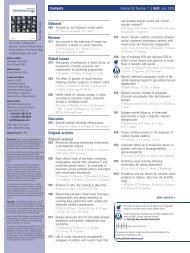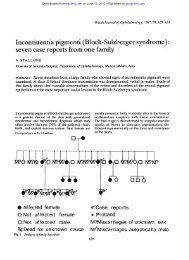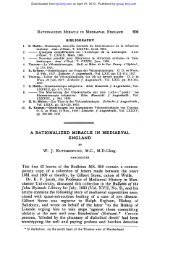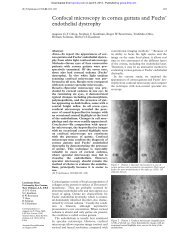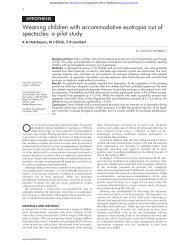ABSTRACTS - British Journal of Ophthalmology
ABSTRACTS - British Journal of Ophthalmology
ABSTRACTS - British Journal of Ophthalmology
Create successful ePaper yourself
Turn your PDF publications into a flip-book with our unique Google optimized e-Paper software.
Downloaded from bjo.bmj.com on August 22, 2013 - Published by<br />
group.bmj.com<br />
520 THE BRITISH JOURNAL OF OPHTHALMOLOGY<br />
ulcerations there is, as a rule, no advantage in the use <strong>of</strong> flavine, but<br />
in hypopyon ulcer a solution <strong>of</strong> flavine can be quite safely used to<br />
wash out the anterior chamber. In relapsing blepharitis an ointment<br />
<strong>of</strong> pr<strong>of</strong>lavine oleate (1 in 1000) had a very good effect in one case,<br />
but the author does not feel justified in making positive statements<br />
as to its use in such conditions.<br />
ERNEST THOMSON.<br />
V.-PREVENTIVE LEGISLATION<br />
(i) Allport, Frank (Chicago).-State legislation concerning wood<br />
alcohol. Ophtulalmology, July, I916.<br />
(1) This is the fourth <strong>of</strong> a series <strong>of</strong> papers by Alilport, dealing<br />
with legislation in the United States in its relation to ophthalmology.<br />
It is now well known that wood alcohol, or methyl alcohol, when<br />
either imbibed or inhaled can produce serious toxic symptoms,<br />
leading to blindness and even to death. Wood alcohol is obtainable<br />
on the market in three forms: (1) in its raw, unpurified form,<br />
which is so foul smelling and disgusting to taste that there is little<br />
danger that it will be used for drinking purposes; (2) denatured,<br />
industrial, or domestic alcohol (our " methylated spirit "), mainly<br />
composed <strong>of</strong> ethyl alcohol, but with enough methyl alcohol added to<br />
render it unfit for consumption; and (3) various forms <strong>of</strong> deodorised<br />
or purified wood alcohol, known as Columbian spirits, Colonial<br />
spirits, etc., from which the odour, taste, and colour <strong>of</strong> wood alcohol<br />
have been removed, but without reduction <strong>of</strong> its intensely poisonous<br />
character.<br />
In the United States especially there have been a large number<br />
<strong>of</strong> cases <strong>of</strong> wood alcohol poisoning due to the internal use <strong>of</strong> one or<br />
other <strong>of</strong> these forms <strong>of</strong> deodorised wood spirits. The danger <strong>of</strong><br />
such an occurrence is much increased by the fact that these are<br />
<strong>of</strong>ten sold without warning as to the poisonous nature <strong>of</strong> the<br />
material and under descriptions which disarm suspicion, for<br />
example: "A pure, refined spirit for domestic use," "A perfect<br />
substitute for grain alcohol." The main point in Allport's paper is<br />
that it is unnecessary to run the risks attached to the use <strong>of</strong> this<br />
substance, since denatured alcohol is equally cheap, is easy to<br />
obtain, and does not involve the same dangers.<br />
Within the last ten years eftorts have been made by legislation<br />
throughout the United States to limit the use <strong>of</strong> wood alcohol.<br />
This paper contains a summary <strong>of</strong> the laws <strong>of</strong> the different States<br />
dealing with the subject. Although these laws are, for the most<br />
part, quite clear, and their intention is well known, it would not be<br />
difficult, as Allport points out, to evade them. He goes so far as to



